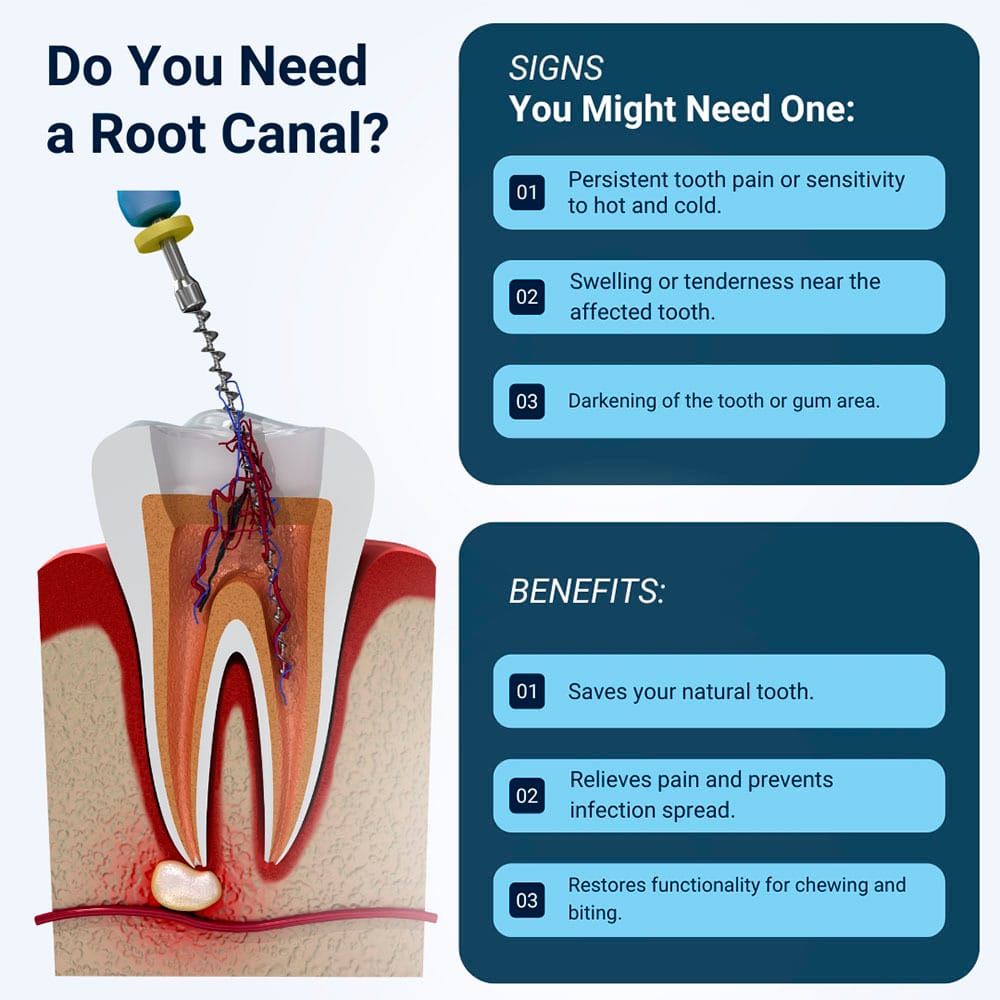Why Is Root Canal Therapy Necessary?
When your teeth are healthy and strong, they have a tough outer layer of enamel protecting them. However, tooth enamel can become damaged due to trauma or tooth decay. If this occurs, bacteria naturally present in your mouth can penetrate the tooth.
Immediately underneath tooth enamel is dentin, a softer material bacteria can more easily destroy. Initially, a cavity develops, but eventually, the cavity will reach the dental pulp right in the tooth center.
The dental pulp contains connective tissues, nerves, and blood vessels. If it becomes infected, it can cause severe pain and inflammation. Root canal treatment is needed to remove the infection.

What Are the Signs That I Need a Root Canal?
Several signs can indicate a tooth has a problem, but the only way to tell for sure is to see your dentist. Below are seven warning symptoms that something is wrong with the tooth.
Read more: 5 Tips for a Fast and easy Post-Gum Graft Recovery
Tooth Pain
The most common symptom of a tooth infection is tooth pain or toothache. The pain may always be present or only when you bite down. It may seem to disappear, especially if the tooth nerve dies due to the infection and inflammation. However, the infection cannot clear up on its own.
If you experience tooth pain, see your dentist as soon as possible. Although other factors can cause the pain, a proper diagnosis and treatment will be needed. The sooner you get treatment, the quicker your dentist can relieve the pain and the better the outcome.
Other potential causes of toothache can include:
- Sinus infection.
- An impacted tooth.
- Gum disease.
Tooth Sensitivity
You should be able to eat and drink hot and cold foods and beverages comfortably. If you have noticed that your teeth have begun to feel sensitive or painful during eating and drinking, it could indicate a problem with that tooth.
The pain can feel sharp or dull and may continue after eating and drinking. The discomfort or pain can indicate that the nerves and blood vessels in the tooth pulp are damaged, infected, or inflamed.
Read more: Metal Crowns vs. Porcelain Dental Crowns
Discolored Tooth
Have you noticed a tooth looks black or gray? It can indicate an infection. When the dental pulp becomes infected and inflamed, the pulp tissues gradually decay, causing tooth discoloration.
Swollen, Red Gums
Strong, healthy gums should not be swollen or red. Gums can start to swell because of the waste products produced by dead and dying pulp tissues.
If you notice the gum around a tooth has become red, tender to touch, and looks swollen, it can indicate an infection, especially if the tooth has recently begun to hurt.
When the infection is particularly severe you may also develop a pimple on the gum, which can mean you have a dental abscess. The pimple is a buildup of pus, and if it begins to ooze, you may develop a nasty taste and very bad breath.
Tooth Pain When Eating
A tooth that has become painful or sensitive when you bite down could have severe tooth decay or infection. Your teeth are held in place by ligaments that attach them to the sockets. These ligaments can become more sensitive if the dental pulp is infected, as the waste products produced by the dying pulp can irritate them. Any pain when you bite down requires urgent investigation.
Broken or Chipped Tooth
If you chip or crack a tooth, getting the damage mended promptly is always important, even if it doesn’t look severe. Damaging your tooth enamel can eventually lead to infection and inflammation as bacteria penetrate the tooth. Even a small crack can open up when you bite down.
If you take a blow to the mouth, the dental pulp can also become injured and inflamed, resulting in tooth sensitivity. Eventually, you may require root canal therapy.
Contact your dental office if you have recently injured a tooth so they can check it out properly and provide any necessary treatment. The earlier you seek professional dental care, the more likely the treatment will be less invasive, quicker, and cheaper.
Read more: The Pros and Cons of a Dental Bridge
Loose Tooth
When a tooth is infected, it can feel loose in its socket. You may be able to move it with your tongue or finger. Teeth can loosen if the infection is severe and spreads to the surrounding bone, eventually destroying it.
It may be possible to save the tooth with root canal therapy, but you must act quickly.
What to Expect If You Need Root Canal Therapy
Root canal treatment has a reputation for being scary and painful, but this isn’t true. It shouldn’t feel any worse than an ordinary filling, but it will take longer to complete.
You won’t feel any pain because your dentist can use a local anesthetic to numb the tooth thoroughly. If you start feeling discomfort during treatment, let your dentist know. They can use more numbing agents to ensure you feel comfortable, as dental treatment should never be painful.
If your tooth infection is severe and has caused other problems like facial swelling, swollen lymph glands, or a fever, you may need antibiotics to help eliminate the infection.
The general process for root canal therapy is outlined below.
- Your tooth is numbed and isolated with a rubber dam to keep it dry during treatment.
- Your dentist will make a small hole in the tooth’s crown so they can see the dental pulp.
- All the tissues in the dental pulp are carefully removed. Your dentist also removes all the tissues extending into the root canals deep into your tooth roots. They use specially shaped files to clean the root canals.
- Once all the dental pulp has been removed, your dentist will irrigate the empty pulp chamber and disinfect it.
- The pulp chamber is sealed with a filling. The filling may be temporary, and the tooth is left to settle for a couple of weeks. This is to ensure all the infection is removed before it is permanently restored.
- During your next visit, your dentist can permanently fill the tooth with gutta-percha that seals it completely.
- They will prepare the tooth for a dental crown that covers it completely. This is usually necessary because infected teeth tend to lose a large part of their original structure.
- While your crown is made, a temporary crown is fitted over the tooth.
- At your next visit, your dentist will remove the temporary crown and fit your permanent crown.
- When your dentist is happy with the crown’s fit, they will cement it permanently in place, completing your treatment.
Simply placing a filling wouldn’t be strong enough to restore the tooth fully.
How Long Will a Root Canal Last?
After your tooth is restored, a root canal can last for life, provided you practice good oral care and see your dentist regularly for checkups. However, a tooth can sometimes become reinfected after root canal therapy, even years later.
If your tooth does become reinfected, your dentist may be able to treat it again. They may refer you to an endodontist, a dental specialist in root canal therapy, for a more thorough assessment. If the reinfection is too severe, you may be recommended to have the tooth extracted and consider other ways to replace it. The most advanced way is to have a dental implant, which might be a better investment than trying to save the tooth.
Read more: What are the Stages of Periodontal Disease?
Can Root Canal Therapy Save Every Tooth?
Not every tooth can be saved by root canal therapy. If the infection is severe and has progressed into a dental abscess, your dentist may need to remove the tooth to allow the abscess to drain.
There is a far better chance that root canal therapy could save an infected tooth if you see your dentist quickly. If you have noticed a tooth feels uncomfortable or painful, don’t delay but contact your dental office immediately.

